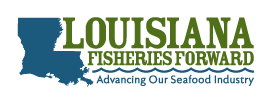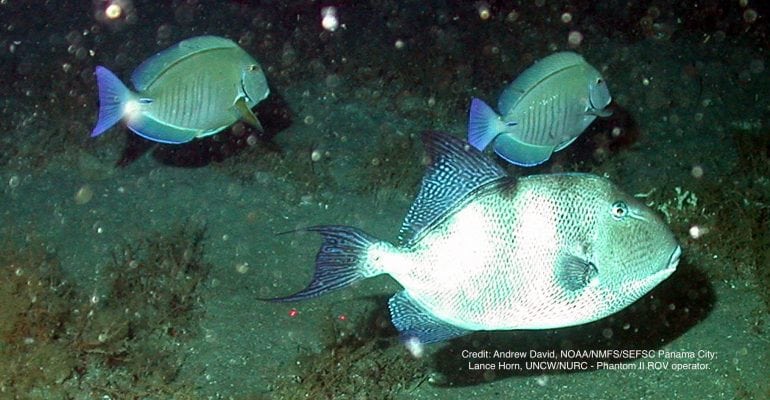
Since completion of the stock assessment, anecdotal information indicates that the red grouper stock has grown since the 2017, which is the last year of data incorporated in SEDAR 61. To investigate this further, the Council has requested an interim red grouper analysis that will incorporate more recent changes in the relative stock abundance into management advice. The Council will submit the proposed changes in Reef Fish Amendment 53 to the Secretary of Commerce for approval and implementation as soon as practicable.
Shrimp
The Council began work on a Framework Action to transition the federal shrimp fleet to a new platform for data transmission to replace the expired 3G cellular electronic logbook program. Cellular electronic logbook units stopped transmitting shrimp effort data at the end of 2020. The Council modified the purpose of the document to include language specifying that any economic burden on the industry, resulting from the document, should be minimized to the extent practicable. The Council modified an existing alternative and added a new alternative to clarify the different vessel position reporting devices that could be selected for use. The Council is expected to continue work on this document at a future meeting.
The Council also decided to move forward with a call for proposals to test a software program for effort monitoring with a portion of the shrimp fleet to determine if it meets the needs of the industry, Council, and the NMFS Southeast Fisheries Science Center. The Council decided to put $350,000 towards the awarded project, which is anticipated to take 12-18 months to complete.
Gray Triggerfish
The Council decided to fund a call for proposals to obtain information to decrease data gaps in the gray triggerfish stock assessment that is scheduled to begin in 2024. The proposed project is expected to efficiently sample, process, and utilize different ageing structures such as spines and otoliths for gray triggerfish in the Gulf of Mexico. The Council decided to put $250,000 towards the awarded project, which is anticipated to take two years to complete.
Cobia
The Council reviewed a draft of Costal Migratory Pelagics Amendment 32, which considers modifying cobia catch limits; apportionment between the Gulf and Florida East Coast (FLEC) Zones; sector allocations in the FLEC zone; and management measures including possession limits, vessel/trip limits, and minimum size limits. A recent update stock assessment for cobia showed that the stock is not overfished but is currently experiencing overfishing. The assessment used the new Marine Recreational Information Program’s Fishing Effort Survey (MRIP-FES) data, which increased the estimates of recreational catch and effort. Based on the assessment, the Council’s Scientific and Statistical Committee recommended new overfishing limits and acceptable biological catch levels for 2021-2023 and beyond. While the assessment projections appear to allow for increased harvest, they actually represent an approximate 30% reduction from the current allowable harvest. The Council selected preferred alternatives that would retain the 8% commercial and 92% recreational cobia allocation in the FLEC zone and use the Gulf Council’s ACL/ACT Control Rule to calculate annual catch targets for the recreational sector in the FLEC Zone and for the stock annual catch target in the Gulf Zone. The Council also selected a preferred alternative that would reduce the commercial daily possession limit to 1 cobia per person regardless of the number or duration of trips. Finally, the Council selected a preferred alternative that would modify the Framework Procedure to expand the South Atlantic Council’s responsibilities in the management of cobia in the FLEC Zone. The Council plans to continue work on this document at its next meeting.
King Mackerel
The Council continued to work on a draft of Coastal Migratory Pelagics Amendment 33, which considers modifying Gulf king mackerel catch limits and modifying sector allocations. The recent SEDAR 38 Update stock assessment determined that Gulf king mackerel is not overfished and is not experiencing overfishing. The update assessment used the new Marine Recreational Information Program Fishing Effort Survey (MRIP-FES) recreational landings and effort estimates, which nearly doubled historic estimates of recreational harvest. Based on the results of the update assessment, the Council’s Scientific and Statistical Committee recommended new Gulf king mackerel overfishing limit and acceptable biological catch levels for 2021-2023 and subsequent years. Since the recreational sector has not caught its allocation of king mackerel in over 20 years, the Council asked staff to update the document by adding alternatives that consider shifting allocation to the commercial sector. The Council is expected to continue work on this amendment during a future meeting.
Greater Amberjack
A recent stock assessment (SEDAR 70) determined that greater amberjack continues to be overfished and undergoing overfishing. The assessment used the new Marine Recreational Information Program Fishing Effort Survey (MRIP-FES) recreational landings and effort estimates, which more than double previous estimates of recreational harvest. The Council is expected to continue work on this amendment at a future meeting.
Essential Fish Habitat
Essential Fish Habitat (EFH) is defined as those waters and substrates necessary to fish for spawning, breeding, or growth to maturity. Each Fishery Management Plan (FMP) developed by the Council must identify and describe EFH. EFH designation does not require additional, place-based fishing regulations; however, it does require NOAA consultation to ensure that activities that occur within EFH minimize or prevent environmental impacts. The Council completed its first Generic EFH Amendment in 2006, and has conducted two 5-year reviews since. At this meeting, the Council began work on a new draft Generic EFH Amendment which considers updating the methods used to describe and identify EFH for Shrimp, Reef fish, Coastal Migratory Pelagics, Spiny Lobster, and Red Drum FMPs. The Council’s Scientific and Statistical Committee will review the new methodologies before work continues on the amendment.
Executive Order 14008: Tackling the Climate Crisis at Home and Abroad
The Council heard a presentation on the Executive Order which aims to place the climate crisis at the forefront of the Nation’s foreign policy and national security planning. Section 216 of the Executive Order: Conserving our Nation’s Land and Waters, creates a goal to conserve at least 30 percent of our lands and waters by 2030. The Council also reviewed public comments solicited along with a draft recommendation letter that will be submitted in response to Executive Order. The letter will be formally submitted to the Deputy Assistant Administrator for Operations at NOAA Fisheries once it is finalized.
Red DrumThe Council discussed extending state management of red drum for Alabama, Mississippi, and Louisiana out to 9 nautical miles (the federal waters already begin 9 nautical miles off the coasts of Florida and Texas). The options available to the Council would require the development of an annual catch limit for red drum in federal waters, which have been closed to harvest since 1987. The Council decided to postpone consideration of further action until pending research on the adult portion of the red drum stock may be available.
Electronic Reporting Equipment Failure
The Council began working on a framework action to ensure that for-hire and commercial trips are not delayed or canceled in the event of equipment failures. Vessels with commercial reef fish permits are currently required to be equipped with VMS systems that transmit location data to NOAA Fisheries once an hour. Vessels with Charter/Headboat permits for reef fish or coastal migratory pelagics will soon be required to be equipped with a satellite or cellular position reporting unit that operates 24-hours a day, collects location data once an hour, and automatically transmits data to NOAA Fisheries. The Council directed staff to develop alternatives for both for-hire and commercial sectors that consider mechanisms for allowing and documenting exemptions if position reporting equipment fails. The Council discussed delaying implementation of for-hire location reporting requirements until solutions to prevent vessels from being tied to the dock are developed further. The Council decided to convene its Data Collection Advisory Panel to recommend options to address position reporting equipment failure concerns.
Individual Fishing Quota ProgramsThe Council continued to work on Reef Fish Amendment 36B which considers requiring individual fishing quota (IFQ) shareholder accounts to be associated with a commercial reef fish permit. The Council chose a preferred alternative that would require shareholder accounts with shares established after implementation of the amendment to be associated with a commercial reef fish permit. The Council also selected a preferred alternative that would allow NMFS to reclaim any shares in a shareholder account that is not associated with a permit three years after an associated permit is terminated. The Council plans to review the amendment again to consider several outstanding questions and refine the purpose and need.
Reef Fish and Shrimp Advisory Panels
The Council populated its Reef Fish and Shrimp Advisory Panels. These Advisory Panels are comprised of people who are knowledgeable about a particular fishery and advise the Council on issues related to their expertise. The list of people who have been selected to serve for a three-year term can be found here.
Scientific and Statistical Committee
The Council populated its Standing, Special Red Drum, Special Reef Fish, Special Socioeconomic, and Special Ecosystem Scientific and Statistical Committees. The list of people who have been selected to serve for a three-year term can be found here.
The Council will re-advertise to populate its Special Coral, Special Mackerel, and Special Shrimp SSCs before appointing new members. The Scientific and Statistical Committees are comprised of professional economists, biologists, and sociologists that advise the Council on the scientific, technical, social, and economic aspects of the fisheries in the Gulf.





